Bank transactions provide reconciliation information for postings made to GL bank accounts including postings from all subsidiary ledgers as well as manual postings to GL. Bank Reconciliation provides a complete reconciliation for all entries made to the GL bank account. Bank transactions are reconciled by assigning them to a bank statement. A transaction is considered "outstanding" if it is not assigned to a bank statement.
When a GL bank account is initially assigned to a check register, ActivityHD creates bank transactions for all existing journal entries to the GL bank account. Thereafter, bank transactions for journal entries are created when an entry is merged to the GL account.
Bank transactions for an existing payment or other posting cannot be created manually. A bank transaction is created when its document is merged into GL. Existing bank transactions can be edited to add supplementary information that is relevant to the entry's reconciliation.
![]() Reconcile a bank transaction in the Bank Transaction window
Reconcile a bank transaction in the Bank Transaction window
Reconcile a bank transaction in the Bank Transaction window
Before you can reconcile a transaction, you must set up a bank statement to reconcile the transaction to. You can reconcile a transaction from the Bank Transaction window by assigning it to a statement and providing the date the transaction cleared.
- In the Navigation pane, highlight the Bank Reconciliation > Transactions folder.
- In the HD view, locate and double-click the transaction to reconcile to open it in the Bank Transaction window.
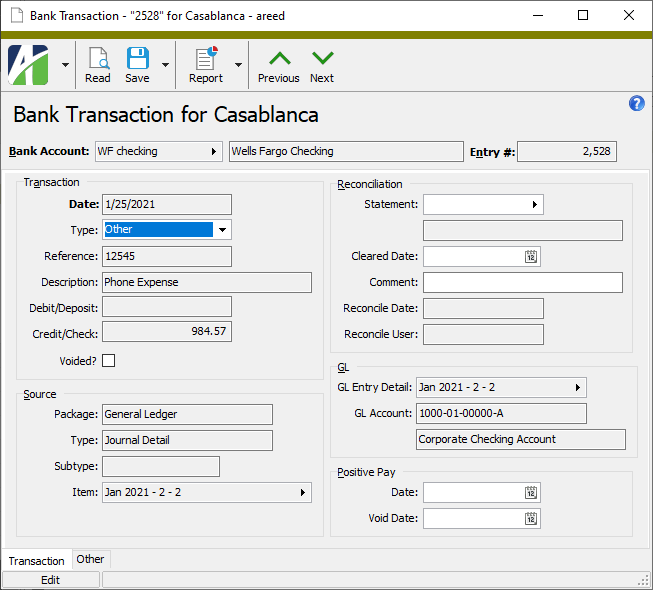
- In the Statement field, select the statement to reconcile the transaction to.
- In the Cleared Date field, enter the date as of which to flag the transaction as cleared.
- Enter a Comment about the transaction or its reconciliation, if desired.
- Save the changes to the transaction.
![]() Reconcile transactions from the Transactions folder
Reconcile transactions from the Transactions folder
Before you can reconcile transactions, you must set up a bank statement to reconcile the transactions to. You can reconcile transactions from the Transactions folder by assigning them to a statement and providing the date the transactions cleared.
Reconcile transactions from the Transactions folder
- In the Navigation pane, highlight the Bank Reconciliation > Transactions folder.
- Start the Reconcile Transactions wizard.
- To reconcile all or a filtered subset of transactions:
- Right-click the Transactions folder and select Select and Reconcile from the shortcut menu.
- On the Selection tab, define any filters to apply to the data.
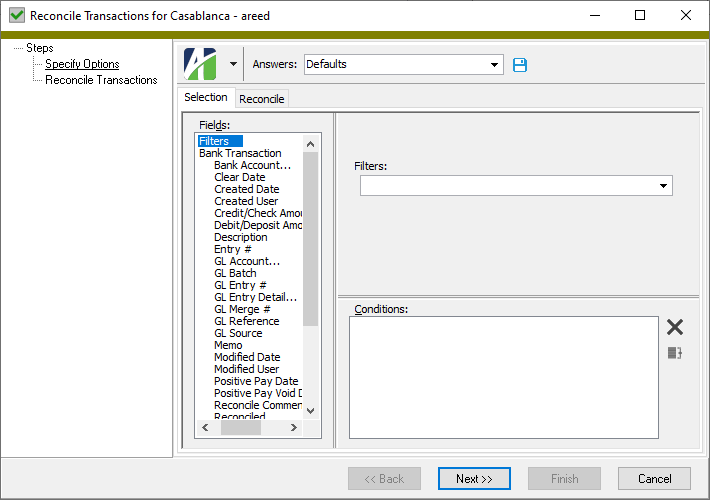
Tip
Apply the "Unreconciled Transactions" filter to select unreconciled transactions.
- To reconcile specifically selected transactions:
In the HD view, select the transactions to reconcile. You can use Ctrl and/or Shift selection to select multiple transactions.
Tip
Apply the "Unreconciled Transactions" filter to see all unreconciled transactions.
- Click
 .
.
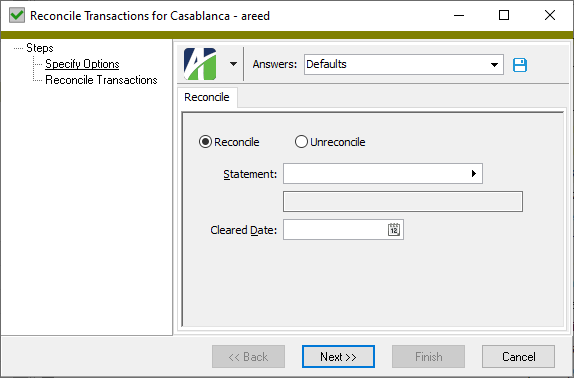
- To reconcile all or a filtered subset of transactions:
- On the Reconcile tab in the Statement field, select the bank statement to reconcile the transactions to.
- In the Cleared Date field, enter the date as of which to flag the transactions as cleared.
- Click Next >>. ActivityHD prompts you to confirm the action.

- Click Yes.
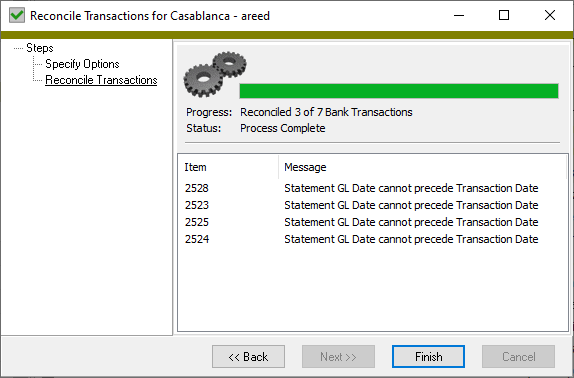
- Click Finish.
![]() Unreconcile a bank transaction in the Bank Transaction window
Unreconcile a bank transaction in the Bank Transaction window
Occasionally you may reconcile a transaction by mistake and need to "unreconcile" it, or return it to the list of transactions to be reconciled. To do this in the Bank Transaction window, you clear the statement the transaction is assigned to.
Unreconcile a bank transaction in the Bank Transaction window
- In the Navigation pane, highlight the Bank Reconciliation > Transactions folder.
- In the HD view, locate and double-click the transaction to unreconcile to open it in the Bank Transaction window.

- Clear the Statement field.
- Clear the Cleared Date field.
- Save the changes to the transaction.
![]() Unreconcile bank transactions from the Transactions folder
Unreconcile bank transactions from the Transactions folder
Occasionally you may reconcile transactions by mistake and need to "unreconcile" them, or return them to the list of transactions to be reconciled. To do this from the Transactions folder, you'll use the Reconcile Transactions wizard.
Unreconcile bank transactions from the Transactions folder
- In the Navigation pane, highlight the Bank Reconciliation > Transactions folder.
- Start the Reconcile Transactions wizard.
- To unreconcile a filtered subset of transactions:
- Right-click the Transactions folder and select Select and Reconcile from the shortcut menu.
- On the Selection tab, define any filters to apply to the data.

- To unreconcile specifically selected transactions:
- In the HD view, select the transactions to unreconcile. You can use Ctrl and/or Shift selection to select multiple transactions.
- Click
 .
.

- To unreconcile a filtered subset of transactions:
- On the Reconcile tab, select the "Unreconcile" option.
- Click Next >>. ActivityHD prompts you to confirm the action.

- Click Yes.

- Click Finish.
Positive pay is a check fraud prevention measure that ensures that the checks presented for payment to your bank match items on a list of checks issued by your organization. The positive pay feature in ActivityHD allows you to produce a report which contains information such as check number, bank account number, check date, and payment date. The positive pay report is sent to the bank so the bank can verify the checks to be paid.
A transaction is not eligible for positive pay if it:
- has already been reconciled.
- has already been positive paid.
- is not a check.
- has been voided and the voided check wasn't previously positive paid.
Tip
To see which transactions are eligible for positive pay without running the Positive Pay Transactions wizard, apply the "Ready for Positive Pay" filter on the Transactions HD view.
Note
If two name lines are used on checks, some banks require both names to be included in the positive pay file you submit to them. For this reason, all address fields are available to be reported for payroll check disbursements and AP check payments.
To create the positive pay report:
Create the positive pay report
- In the Navigation pane, highlight the Bank Reconciliation > Transactions folder.
- Start the Positive Pay Transactions wizard.
- To produce the positive pay report for all or a filtered subset of bank transactions:
- Right-click the Transactions folder and select Select and Positive Pay from the shortcut menu.
- On the Selection tab, define any filters to apply to the data.

Tip
Apply the "Ready for Positive Pay" filter to select transactions that are eligible for positive pay.
- To produce the positive pay report for specifically selected transactions:
In the HD view, select the transactions to include on the positive pay report. You can use Ctrl and/or Shift selection to select multiple transactions.
Tip
Apply the "Ready for Positive Pay" filter to see all transactions that are eligible for positive pay.
- Click
 .
.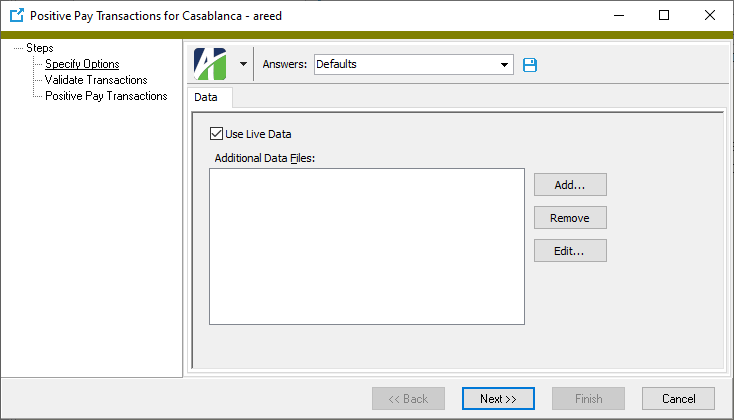
- To produce the positive pay report for all or a filtered subset of bank transactions:
- On the Data tab, ensure the Use Live Data checkbox is marked if you want to use data from the currently selected transactions on the report.
-
If you need to include XML data from other files that were generated by ActivityHD or by an external source, add them to the Additional Data Files list box. To do so, do the following for each file you need to add:
Note
If extended views exist for the Postive Pay Report, you cannot include additional files since files built from different extended views may be incompatible.
- Click Next >>. ActivityHD validates the transactions and reports its results.
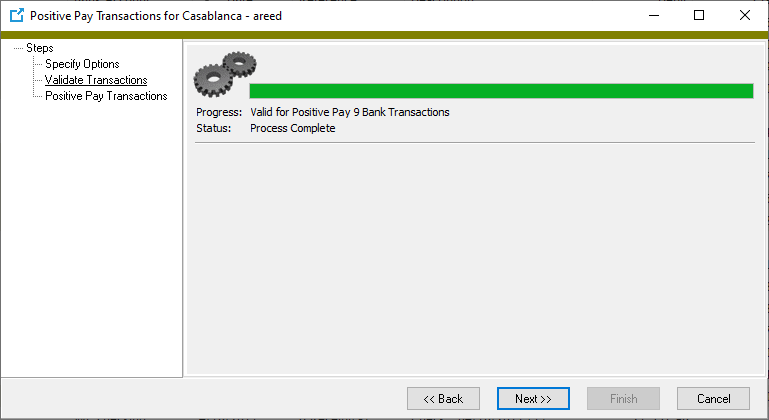
- Click Next >>. ActivityHD lists the positive pay transactions.
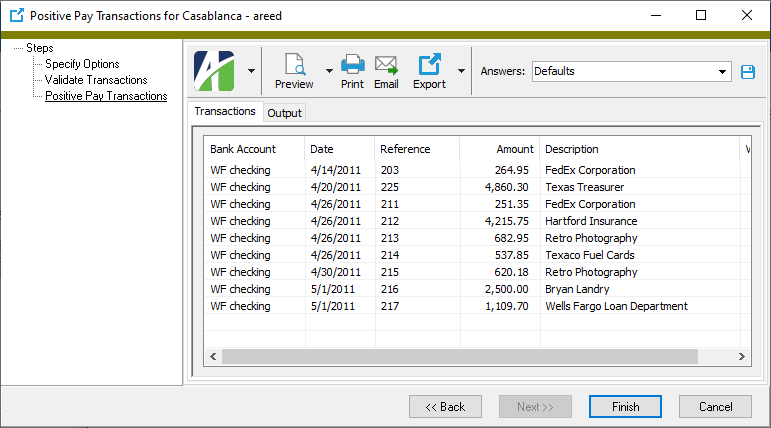
- Select the Output tab.
- In the Design field, look up and select the report design to use.
- In the toolbar, click the icon for the type of output you want:
 - Provides access to two preview options.
- Provides access to two preview options.- Preview - Click the icon or click the drop-down arrow and select Preview from the drop-down menu to view the report in the Crystal Reports viewer.
- Preview to PDF - Click the drop-down arrow next to the icon and select Preview to PDF to view the report in the PDF reader.
 - Opens the Print dialog so that you can select and configure a printer and then print a paper copy of the report.
- Opens the Print dialog so that you can select and configure a printer and then print a paper copy of the report. - Opens the Report Email Options dialog so that you can address and compose an email that the report will be attached to.
- Opens the Report Email Options dialog so that you can address and compose an email that the report will be attached to. - Opens the Export Report dialog so that you can save the report to a file. File types include Crystal Reports (.rpt), PDF (.pdf), Microsoft Excel (.xls), Microsoft Word (.doc), rich text (.rtf), and XML (.xml).
- Opens the Export Report dialog so that you can save the report to a file. File types include Crystal Reports (.rpt), PDF (.pdf), Microsoft Excel (.xls), Microsoft Word (.doc), rich text (.rtf), and XML (.xml).
Two additional options are available from a drop-down menu if you click the down arrow next to the Export button: Flatfile and Data to XML. Select Flatfile to save data only to a text file. Select Data to XML to save data only to an XML file. These formats are provided for banks which provide electronic positive pay.
- When you have produced the desired output, click Finish. ActivityHD asks if you're ready to mark the transactions as positive paid.

- Click Yes.
Data extensions
The following data extension is available for the report:
- Transactions
If the transaction type is incorrect on a transaction, you can correct it in the Bank Transactions window.
- In the Navigation pane, highlight the Bank Reconciliation > Transactions folder.
- In the HD view, locate and double-click the transaction to open it in the Bank Transaction window.

- From the Type drop-down list, select the transaction type. Your options are:
- Check
- Deposit
- Fee
- Interest
- Transfer
- Void
- Other
- Save the changes to the transaction.
![]() Flag a transaction as positive pay
Flag a transaction as positive pay
You can add a transaction to the positive pay list and mark it as positive paid in the Bank Transaction window.
- In the Navigation pane, highlight the Bank Reconciliation > Transactions folder.
- In the HD view, locate and double-click the transaction to open it in the Bank Transaction window.

- In the Date field in the Positive Pay section, enter the date to mark the transaction as positive paid.
- Save the changes to the transaction.
![]() Flag a voided positive pay transaction
Flag a voided positive pay transaction
You can flag a positive pay transaction as voided in the Bank Transaction window.
- In the Navigation pane, highlight the Bank Reconciliation > Transactions folder.
- In the HD view, locate and double-click the transaction to open it in the Bank Transaction window.
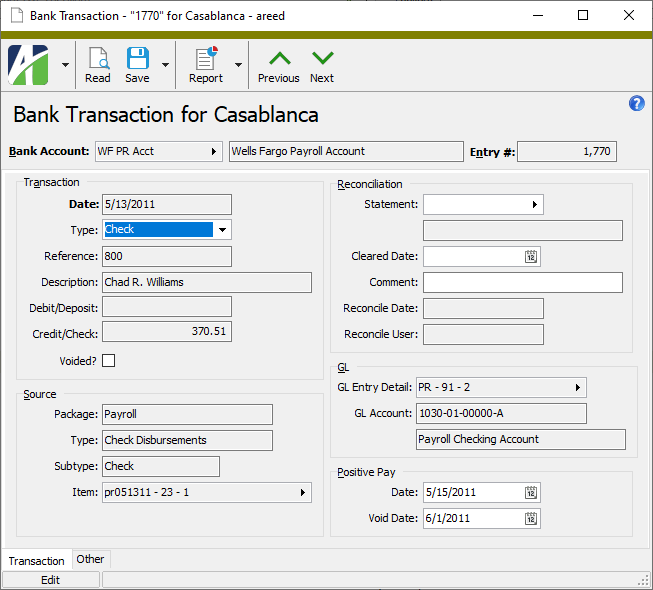
- In the Void Date field in the Positive Pay section, enter the date the positive pay transaction was voided.
- Save the changes to the transaction.
Bank Transactions Listing
Purpose
The Bank Transactions Listing provides a list of the bank transactions recorded in Bank Reconciliation.
Content
For each bank transaction included on the report, the listing shows:
- entry number
- bank account name
- transaction date
- reference
- description
- statement date
- whether the transaction is voided
- if a debit, the debit amount
- if a credit, the credit amount.
In addition, you can include one or more of the following:
- reconciliation detail (date reconciled, date cleared, user who reconciled)
- source and positive pay detail (batch - entry number - line number for GL entry, GL account, source package, source type, and record identifier [format depends on source type])
- timestamps
- memos
- custom fields.
The following totals appear on the report:
- grand totals.
Print the report
- In the Navigation pane, highlight the Bank Reconciliation > Transactions folder.
- Start the report set-up wizard.
- To report on all or a filtered subset of bank transactions:
- Right-click the Transactions folder and select Select and Report > Bank Transactions Listing from the shortcut menu.
- On the Selection tab, define any filters to apply to the data.

- To report on specifically selected bank transactions:
- In the HD view, select the bank transactions to include on the report. You can use Ctrl and/or Shift selection to select multiple records.
- Click
 .
.
- To report on a particular bank statement from the Bank Statement window:
- In the HD view, locate and double-click the bank statement to report on. The Bank Statement window opens with the bank statement loaded.
- Click
 .
.
- To report on all or a filtered subset of bank transactions:
- Select the Options tab.
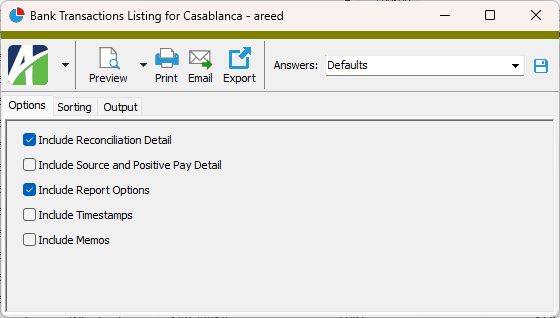
- Mark the checkbox(es) for the additional information to include:
- Reconciliation Detail
- Source and Positive Pay Detail
- Report Options. To include a section at the end of the report with the report settings used to produce the report, leave the checkbox marked. To produce the report without this information, clear the checkbox.
- Timestamps
- Memos
- Custom Fields (only visible if custom fields are set up)
- Select the Sorting tab.
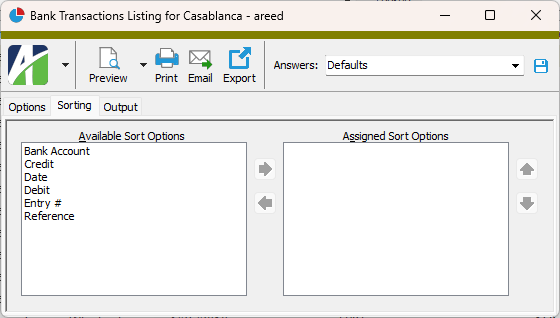
- In the Available Sort Options list box, highlight the field(s) to sort the report by, then click
 to move your selection(s) to the Assigned Sort Options list box.
to move your selection(s) to the Assigned Sort Options list box. - If you selected multiple sort fields, use
 and
and  to arrange the sort fields in the order you want them applied.
to arrange the sort fields in the order you want them applied. - Select the Output tab.
- In the Design field, look up and select the report design to use.
- In the toolbar, click the icon for the type of output you want:
 - Provides access to two preview options.
- Provides access to two preview options.- Preview - Click the icon or click the drop-down arrow and select Preview from the drop-down menu to view the report in the Crystal Reports viewer.
- Preview to PDF - Click the drop-down arrow next to the icon and select Preview to PDF to view the report in the PDF reader.
 - Opens the Print dialog so that you can select and configure a printer and then print a paper copy of the report.
- Opens the Print dialog so that you can select and configure a printer and then print a paper copy of the report. - Opens the Report Email dialog so that you can address and compose an email that the report will be attached to. For best results, ensure your email client is running before you attempt to send a report via email.
- Opens the Report Email dialog so that you can address and compose an email that the report will be attached to. For best results, ensure your email client is running before you attempt to send a report via email. - Opens the Export Report dialog so that you can save the report to a file. File types include Crystal Reports (.rpt), PDF (.pdf), Microsoft Excel (.xls), Microsoft Word (.doc), rich text (.rtf), and XML (.xml).
- Opens the Export Report dialog so that you can save the report to a file. File types include Crystal Reports (.rpt), PDF (.pdf), Microsoft Excel (.xls), Microsoft Word (.doc), rich text (.rtf), and XML (.xml).
Data extensions
The following data extension is available for the report:
- Transactions
Bank Transaction Record ID
The bank account associated with the transaction.
Press F3 to look up the value.
If a value is already selected, you can press F4 to open the record in its native editor.
Transaction tab
The type of bank transaction. From the drop-down list, select from among these valid transaction types:
- Check
- Deposit
- Fee
- Interest
- Transfer
- Void
- Other
Note
The positive pay process only extracts transactions of "Check" type.
Use this field to drill down to the underlying transaction.
Note
Since the Payroll package does not currently provide a folder for direct deposit items, the Source Item field is blank for direct deposit transactions.
Press F3 to look up the value.
If a value is already selected, you can press F4 to open the record in its native editor.
If the bank transaction is currently outstanding, this field is blank. If the bank transaction has cleared the bank, this field indicates the statement date of the bank statement on which the bank transaction was cleared. The bank account on the statement and the bank account on the transaction must match.
Press F3 to look up the value.
If a value is already selected, you can press F4 to open the record in its native editor.
The entry batch, sequence number, and detail line number of the journal detail entry that generated the bank transaction.
The information provided here can help you research the source of the bank transaction. When you drill down on this field to the underlying journal detail record, the Journal Detail window contains a tab that shows the subsidiary ledger source documents.
Press F3 to look up the value.
If a value is already selected, you can press F4 to open the record in its native editor.
Custom tab
This tab is visible if custom fields exist for the entity. At a minimum, if there are custom fields, a Fields subtab will be present. One or more additional categories of subtabs may also be visible.
Fields subtab
This tab prompts for values for any custom fields set up for entity records of this entity type. Respond to the prompts as appropriate.
References subtab
This tab is visible if other records reference the current record.
Example
Suppose a custom field exists on PRCodes that references an ARCode. On the ARCode record, on the Custom > References subtab, you can view all the PRCodes which reference that ARCode.
Exchange Folder subtab
This tab is visible only if you set up a custom field with a data type of "Exchange Folder". The label on this tab is the name assigned to the custom field.
This tab shows the contents of the specified Exchange folder.
File subtab
This tab is visible only if you set up a custom field with a data type of "File". The label on the tab is the name assigned to the custom field.
This tab renders the contents of the specified file according to its file type.
Internet Address subtab
This tab is visible only if you set up a custom field with a data type of "Internet Address". The label on this tab is the name assigned to the custom field.
This tab shows the contents of the specified web page.
Network Folder subtab
This tab is visible only if you set up a custom field with a data type of "Network Folder". The label on this tab is the name assigned to the custom field.
This tab shows the contents of the specified network folder.
Attachments tab
The Attachments tab is visible if any record for a given entity has an attachment. If the Attachments tab is not visible, this implies that no record of the entity type has an attachment on it; however, once an attachment is added to any record of the entity type, the Attachments tab will become available.
Other tab

|
Extras\Bank Reconciliation\Import Bank Reconciliation.xls |
Bank transactions security
Common accesses available on bank transactions
| Access | A user with this access can... |
|---|---|
| Change | Use the mass change action on bank transactions. |
| Custom Fields | Create and edit custom fields for bank transactions. |
| Data | Have read-only access to bank transactions from anywhere in the software (e.g., field validations, filters, date expressions). |
| Edit | Edit bank transaction records. |
| Export | Export bank transaction records from ActivityHD. |
| Read | Have read-only access to bank transaction records. |
| Report | Run reports with bank transaction information. |
| Report Designs | Create and edit report designs with bank transaction information. This access enables the Report Designs button on the Output tab of report dialogs. |
| Shared Answers | Create and edit action profiles and report profiles related to bank transactions. |
| Shared Filters | Create and edit shared filters on bank transactions. |
| Visible | View the Bank Transactions folder in the Navigation pane. |
Special accesses available on bank transactions
| Access | A user with this access can... |
|---|---|
| Positive Pay | Create a positive pay file. |
| Reconcile | Reconcile bank transactions to a bank statement. |
Bank transactions filters
The following built-in filters are available for bank transactions:
| Filter Name | Effect |
|---|---|
| ? Amount Range | Prompts for a range of amounts and lists the bank transactions with a debit or credit in that range. |
| ? Bank Account | Prompts for a bank account and lists the bank transactions for the bank account. |
| ? Date Range | Prompts for a range of dates and lists the bank transactions with a transaction date in that date range. |
| Ready for Positive Pay | Lists the bank transactions that are ready for positive pay. |
| Unreconciled Transactions | Lists unreconciled bank transactions only. |
Report Email dialog
- Windows user default account. Sends email using the user's Windows default email account. For most users, this is the account configured in Outlook or another email client application.
- Server personal. Sends email using the email configuration for the system or company server and the email address on the current user's authorized user record. The authorized user record must have a confirmed email address.
- Server generic. Sends email using the email configuration and "from" address for the system or company server. This option requires "Send generic" access to the Server Email resource.
|
5225 S Loop 289, #207 Lubbock, TX 79424 806.687.8500 | 800.354.7152 |
© 2025 AccountingWare, LLC All rights reserved. |
